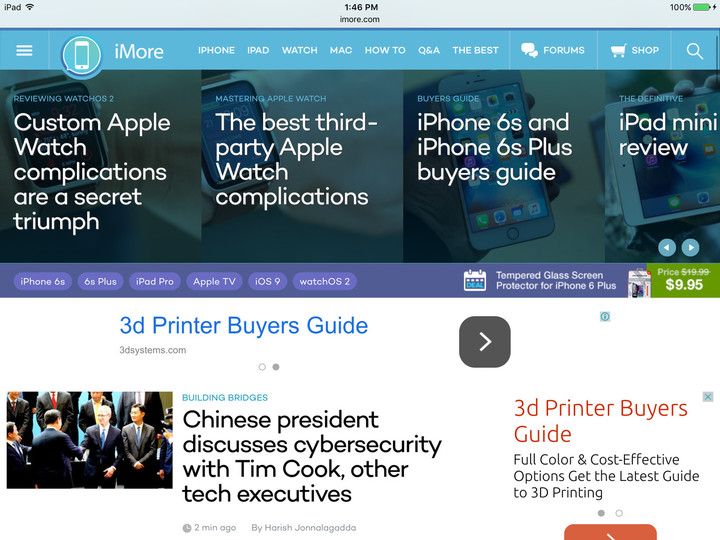
The Best Ad Blockers And Should You Use Them
To block or not to use ad blockers? That is — or at least it ought to be — the question in the minds of iPhone, iPod touch and iPad users who are using any version of iOS 9 or newer (that’s when the ability was enabled).
Officially iOS calls them content blockers. Content blockers are app extensions that enable users to block certain types of content while browsing the Web in Safari on iOS. Content types that may be blocked include — but are certainly not limited to — social media widgets, custom Web fonts, adult sites, and most notably, ads and their attendant trackers.
All ad blockers are content blockers, but not all content blockers are ad blockers
Indeed, owing to their perceived primary purpose of getting rid of Web advertisements, content blockers are practically synonymous to ad blockers. (Just to clarify, though: At least on iOS, All ad blockers are content blockers, but not all content blockers are ad blockers.)
But when is it OK, if at all, to use ad blockers, considering that online advertising constitutes the main source of revenue for the vast majority of Web publishers? And if you do decide to do away with online advertising while using Safari on your iOS devices, what’s the best ad blocker that you can use?
This AppAdvice article seeks to provide answers to those questions and more, but mainly … To block or not to block?
The pros and cons of ad blockers
The cases for and against ad blocking
Advertising is not nearly as predictable online as it is on air or in print
Advertising is more or less consistent across different channels on television and across different publications in print. That is to say, you expect the TV show you’re watching to be interrupted by brief commercial breaks, and the newspaper article you’re reading to be stopped mid-sentence and continued on another page in favor of print ads.
But advertising is not nearly as predictable online as it is on air or in print. Online advertising, if truth be told, is an entirely different beast — a ferocious and untamable beast.
If you’re lucky, you get sites like The New York Times, which has minimal and unobtrusive advertising. If you’re really lucky, you get something like John Gruber’s Daring Fireball, whose sole bit of display advertising is a little box on the sidebar. And if you’re really, really lucky, you get sites like AppAdvice, which is 100 percent ad-free.



But the sad reality is that you seldom get lucky when it comes to websites and the ads that they serve as you browse them. More often than not, you get sites that, in their apparent intent to stick ads into every nook and cranny of their pages, go beyond the typical banner ads and make use of more aggressive display ads, such as pesky pop-ups that obscure what you’re viewing and stubborn sidebar skyscrapers that cause webpage scrolling to stutter. What’s more, many ad-crazy sites are liable to employ cookies and scripts that track user information and activity, thereby undermining user privacy and security.
In such cases, the most basic form of ad blocking, i.e., simply ignoring ads, just won’t cut it. Small wonder, then, that there’s a clamor for ad-blocking software, proof of which is the skyrocketing of ad blockers toward the top of the App Store charts shortly after the release of iOS 9. To be sure, ad blockers are enabled on millions and millions of Web browsers on desktop. But the demand for them may very well be more pronounced on mobile, where users spend more and more time browsing and where ads are relatively more space-hogging and their accompanying trackers more time-consuming.
The most basic form of ad blocking — simply ignoring ads — just doesn’t cut it anymore
Mobile ad blocking got arguably its biggest boost with the release of iOS 9 last year. As mentioned, this version of Apple’s mobile operating system for iPhone, iPod touch, and iPad introduced support for filtering out certain types of content (e.g. ads and trackers) in Safari, the default Web browser on iOS.
However, just because you can block ads and trackers doesn’t mean you should — at least not always.
On the one hand, ad blocking is quite beneficial to users in that it significantly improves the overall Web browsing experience. By getting rid of ads, cookies, scripts, resources, and other items irrelevant to the main content of webpages, ad blocking results in faster loading and scrolling. Further, it helps reduce the levels of battery and cellular data consumption that are normally attributed to Web browsing. Further still, it helps thwart malware injections, phishing attempts, and other security exploits.
On the other hand, ad blocking has important implications to Web publishers. To a great many of these individuals and organizations, advertising brings in the money — money that goes toward website operating costs, staff remuneration, and more. It’s largely due to advertising that we get to read and view content on the Web without charge and enjoy services like Google, YouTube, Facebook, and Twitter for free. And when you put a stopper on advertising, Web publishers get badly hit even when they get a considerable number of hits, since your page views no longer generate ad impressions and conversions. Small publishers and websites that don’t actually commit ad and tracker abuse are particularly hurt.
When you put a stopper on advertising, Web publishers get badly hit even when they get a considerable number of hits
Which is why the well-known developer Marco Arment decided to pull his $2.99 all-or-nothing ad-blocker, Peace, off the market just a couple of days after it became the bestselling app on the App Store. “Achieving this much success with Peace just doesn’t feel good,” Arment, who had courted similar controversy with the creation of the ad-stripping read-later service Instapaper, wrote. “Ad blockers come with an important asterisk: while they do benefit a ton of people in major ways, they also hurt some, including many who don’t deserve a hit.”
Read more about the Peace brouhaha
Fortunately, there’s a way to block ads on websites that abuse the Web browsing experience while continuing to support those that don’t. And that’s by maintaining a whitelist of sites and even ad networks that you like or trust.
You just need the right ad-blocking app for the job.
Ad blockers come with an important asterisk ...
- Marco Arment, developer of PeaceEnabling ad blockers
How to get your ad blocker up and running
If you do decide to use an ad blocker, it will please you to know that Apple has made it really easy to enable your chosen ad blocker, or any other content blocker for that matter. Just follow these steps to get started with your ad blocking and begin taking back control over the content you want to see while browsing the Web in Safari on iOS.

Launch the Settings app from the home screen of your iOS device.
Scroll down to the option labeled Safari and tap it.
Scroll down to the option labeled Content Blockers and tap it.
Toggle the switch corresponding to your preferred content blocker to turn it on.
And that’s it. To sum it up: That’s Settings > Safari > Content Blockers > Turn on your chosen content blocker.
You may need to go to the app itself of the ad blocker you’ve enabled to customize its settings and ensure that its blockers are in effect.
You can enable more than one content blocker at once, although doing so may result in page rendition issues.
After enabling your preferred ad blocker, just browse the Web in Safari as you normally would. No need to do anything special therein and no need to alter your browsing habits to activate content blocking. When you visit a page, Safari automatically loads it up minus ads and other page elements which you’ve configured to be blocked, as shown in the side-by-side comparison below.


If, for some reason, you’d like to view a webpage without any content blocking in effect, you can of course go back to the Content Blockers section in the Settings app and disable the content blocker you’ve previously enabled. But there’s a much simpler way: Just long-press the refresh button in Safari and tap “Reload Without Content Blockers” in the pop-up menu.


Block ads for free
1Blocker



If you’re on the lookout for an ad blocker, your chief consideration is likely to be the price. For something that practically prevents websites from making money, ad blockers ideally should be free. But there’s the app business for you: Having to spend a few dollars to get rid of ads virtually forever is certainly an inviting proposition.
Many ad blockers are downloadable for a fee. However, there are ad blockers that may be installed for free, albeit with in-app purchases for unlocking additional features. Arguably the most notable among such ad blockers is 1Blocker.

Preinstalled with thousands of blockers, 1Blocker is a free-to-try content blocker that, provided it’s been duly enabled in Settings, lets you block ads with just a flip of the main switch in the app.
By default, 1Blocker blocks ads only. But it lets you access its Customize section to choose another content type to block.
In its free basic version, 1Blocker lets you enable only one blocker for a certain content type at a time. To access unlimited blocking, i.e., to enable multiple blockers at once, you need to upgrade to the full version of 1Blocker via a one-time in-app purchase worth $2.99.

In addition to ads, 1Blocker lets you block trackers, social media widgets, custom Web fonts, Disqus comments, and adult sites. It also lets you create your own blockers using its built-in editor.
Moreover, 1Blocker lets you customize its preinstalled blockers so that you can unblock your trusted ad networks, trackers, and more.

Whitelist your favorite sites
Purify Blocker



In the wake of the departure of Peace from the ad-blocking app arena, a handful of premium ad blockers have emerged as bestsellers. These include the $0.99 Crystal, the $0.99 Blockr, and the $2.99 Silentium.
But we here at AppAdvice are partial to the $1.99 Purify. And this is not least because of the app’s simplicity and ease of use.
This combination of simplicity and ease of use is evident in its clutter-free Preferences screen, which lets you toggle blocking of ads and tracking and, for more aggressive blocking, of resource types including images, scripts, and custom Web fonts.

And it’s even more evident in the painless way in which it allows you to whitelist sites whose content you wish to view in full and whose advertising efforts you want to continue supporting.
To whitelist sites, you first have to enable Purify’s action extension by tapping More in the bottom row of Safari’s action sheet and turning on the switch for “Purify – Whitelist.”

Then, when you’re on a website in Safari that you want to exempt from Purify’s content blockers, just tap the “Purify – Whitelist” button in Safari’s action sheet to enable whitelisting for that site.

To disable whitelisting for a site while you’re using Safari, just tap the “Purify – Whitelist” button in Safari’s action sheet and turn off the switch for the site. Alternatively, you can disable whitelisting for a site within the Purify app by going to its Whitelisted Sites section in the Preferences tab and deleting the site from the list.
The block party is on
In conclusion
As the proverb goes, necessity is the mother of invention. In the case of online ads and other webpage elements gone awry, there has risen a necessity for means of bringing these things under control. And so we have content blockers, which Apple has deemed fit to support on iOS, at our disposal.
Whether you use content blockers in general and ad blockers in particular is entirely up to you. Doubtless, there are clear benefits of blocking unnecessary webpage elements that work to the detriment of users’ browsing experience, security, and even battery and cellular data consumption. But it’s important to bear in mind that many websites use ads and other types of content in order to offer their services for free, and that many Web publishers live off the content you may be filtering out. It’s a good thing, then, that you can opt to whitelist the sites that don’t abuse advertising, tracking, and whatnot, and therefore deserve your continued support.
In the case of online ads and other webpage elements gone awry, there has risen a necessity for means of bringing these things under control
As a rule, if a site appears to be more concerned with advertising than delivering quality content, I just ignore not only the ads but the site itself. Good riddance! But if a site is sensible in its ad placements in addition to being forthright with its privacy policies, then it’s something whose content I’m more than willing to view in its entirety.
Be that as it may, I have enabled Purify on my iOS devices. For a small one-time fee upon download, the app works simply yet effectively to help purify, as it were, my Safari browsing experience. And it does so while also providing me with a quick and easy way to keep content on my favorite and trusted sites from being blocked.



